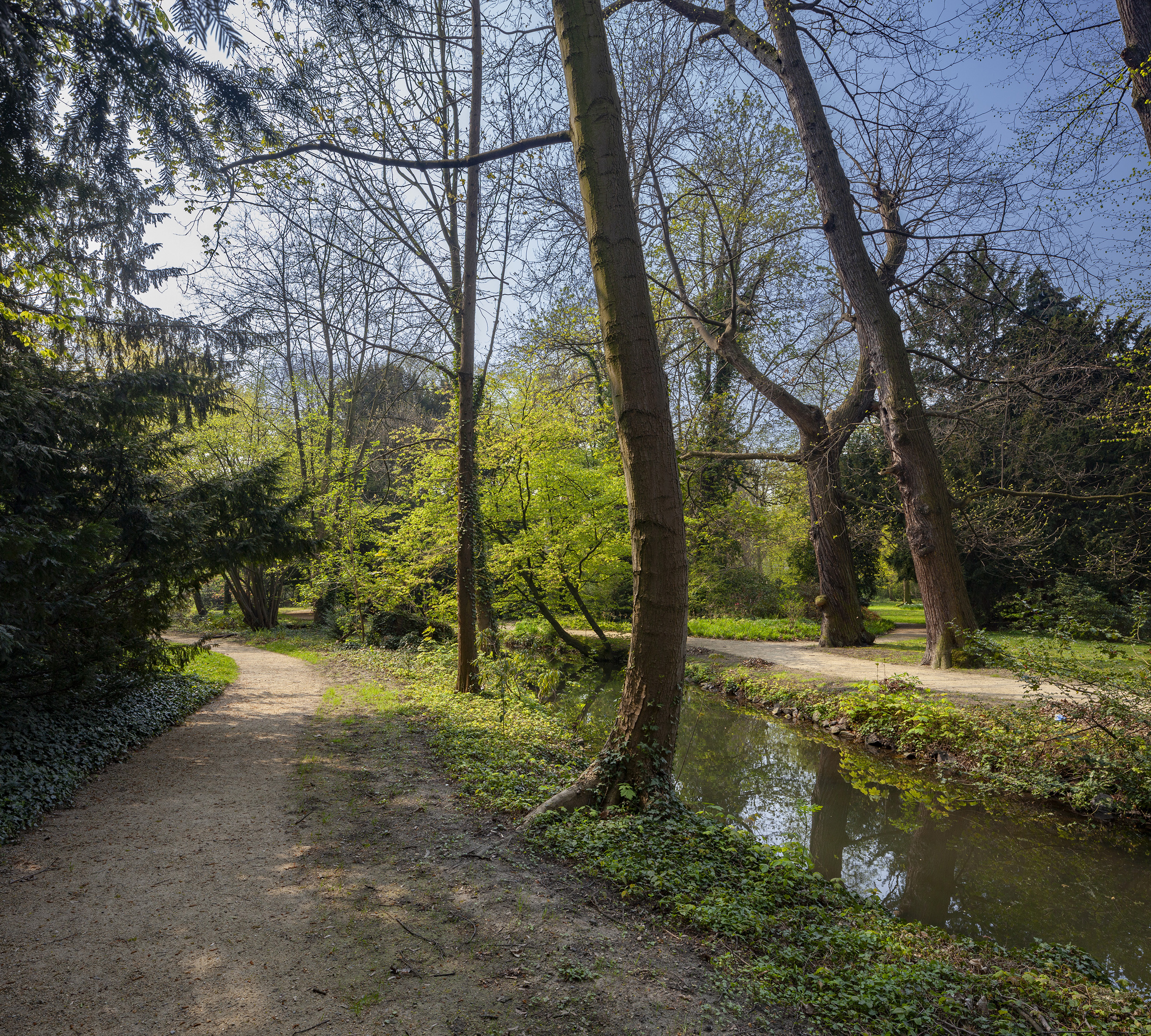Johann Wilhelm Schirmer
Der Jacobigarten in Düsseldorf, 1853 (The Jacobigarten in Düsseldorf)

Johann Wilhelm Schirmer enrolled in the Düsseldorf Academy of Fine Arts in 1825. Soon afterwards, under Wilhelm von Schadow’s directorship,1 this institution would become a leading art school, making Düsseldorf an art centre of international renown. The development of landscape painting was indeed spurred on by impulses from the Düsseldorf academy during this period. The success that Schirmer enjoyed under Schadow is also reflected in his teacher’s decision to have Schirmer and Carl Friedrich Lessing2 stand in for him as teachers of landscape painting while he himself was travelling in Italy in 1830. Ultimately, it was again Schadow whom Schirmer had to thank for his appointment as academy professor in 1839.3 The inspiration for the work under discussion here4 came from Schirmer’s visit to the Jacobigarten about a year before Friedrich I, Prince Regent and soon to be Grand Duke of Baden,5 summoned him to Karlsruhe to become the first director of the new Grand Ducal Art Academy, founded in that city in 1854. Exploring the idyllic, English-style landscape park in Düsseldorf, the painter selected as his vantage point a spot under the tree that frames the work on the right. In front of this tree is a path parallel to a stream meandering into the distance, and, on the left, a sunlit meadow dotted with delicate white, blue, red and yellow flowers that make for an affecting contrast with the dominant green of the verdure. It seems to have been the light that prompted the artist to choose this particular view. The sunlight catching the leaves of the trees turns them bright green and in places actually penetrates the foliage to illuminate parts of the branches and trunks. Following the path as it veers off into the shady thicket, the eye soon loses its way in the semi-darkness – at least until it alights on the little wooden bridge across the northern arm of the River Düssel. Beyond this bridge there is a faint brightening of the colours of the background, which otherwise manages almost entirely without any sky at all. This is no stereotypical composition. On the contrary, the view is framed to lend this landscape moulded by man all the immediacy and intimacy of the natural world. The painter’s precise location was most likely in the south-eastern part of the park (fig. 1). The Jacobi family, after whom it was named, had had their private park laid out in the Baroque style in ca. 1765. About thirty years later, the philosopher and literary scholar Friedrich Heinrich Jacobi6 had it remodelled in line with the prevailing fashions, which meant turning it into an English-style landscape garden that would give it the appearance of untamed nature that it has retained to this day. Jacobi had been inspired to this move by a visit to England and the park at Painshill, which henceforth served him as a model.7 Under Jacobi’s aegis, the Jacobigarten became an important meeting place for many of the leading intellectuals of the day, including Goethe and Herder and the Humboldt brothers.8 The property was put up for sale in the late 1840s and was sold to the Malkasten9 art society in 1861, though Schirmer must have had access to it long before then. This society – the name Malkasten means “paintbox” – was founded in the revolutionary year 1848 for the explicit purpose of giving artists and non-artists10 somewhere to socialize as equals. The image of a paintbox with its paint pans lined up in a row evoked that spirit of egalitarianism. The society quickly became a focal point of the cultural and social life of Düsseldorf, though its pulling power was felt far beyond the Rhineland.11 On acquiring the Jacobigarten, it renamed the park the Malkastengarten and proceeded to use it as a venue for extravagant fêtes featuring performances by musicians, writers and poets. Schirmer was on cordial terms with the Malkasten, and was probably a member of the society for a while; hence its staging of a farewell party in his honour on 2 September 1854, shortly before he left to take up his new position in Karlsruhe.12 Although this painting dates from the previous year it seems almost to look forward to the second intellectual flowering that the property would enjoy under the influence of its new owners.
We would like to thank Mrs. Sabine Schroyen for her assistance with this work.
 Fig. 1 Photo: Holger Klaes, Klaes-images
Fig. 1 Photo: Holger Klaes, Klaes-images
Footnotes
-
Friedrich Wilhelm von Schadow (1788–1862) succeeded Peter von Cornelius (1783–1867) as Director of the Düsseldorf Academy of Fine Arts in 1826. ↩
-
Carl Friedrich Lessing (1808–1880). ↩
-
Johann Wilhelm Schirmer. Vom Rheinland in die Welt,Eine begleitende Publikation zur Verbundausstellung in Düsseldorf, Neuss, Jülich, Bonn, Bergisch Gladbach and Königswinter, vol. 1, Petersberg 2010, p. 19. ↩
-
Johann Wilhelm Schirmer in seiner Zeit, exh. cat. Staatliche Kunsthalle Karlsruhe 2002, Heidelberg 2002, p. 66. ↩
-
Friedrich I, Grand Duke of Baden (1826–1907). ↩
-
Friedrich Heinrich Jacobi (1743–1819). ↩
-
Gundula Lang and Sabine Schroyen, “Der Malkastenpark in Düsseldorf,” in Rheinische Kunststätten No. 555 (2015), p. 10. ↩
-
Johann Wolfgang von Goethe (1749–1832), Johann Gottfried von Herder (1744–1803), Friedrich Wilhelm Heinrich Alexander von Humboldt (1769–1859) and Friedrich Wilhelm Christian Cal Ferdinand von Humboldt (1767–1835). ↩
-
The Kunstverein Malkasten, which has remained the owner of the park to this day, ranks alongside the Verein Berliner Künstler founded in 1841 as one of Germany’s oldest and most illustrious artists’ associations. ↩
-
Robert Schumann (1810–1856), for example. ↩
-
Lang & Schroyen 2015, pp. 3–4. ↩
-
Johann Wilhelm Schirmer in seiner Zeit, exh. cat. Staatliche Kunsthalle Karlsruhe 2002, Heidelberg 2002, p. 68. ↩